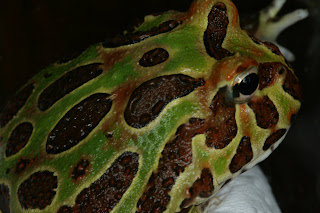Big Mouth!
Some very special spots on the globe reveal important clues to the history of life on Earth. Madagascar is one of these very special places. The continents are on plates that float on the more viscous lower layers of the Earth. Land masses split apart and collide. Often our geographic boundaries of land masses that are not in accord with their geologic boundaries. For example, what we define as the combined continent of Eurasia is actually comprised of land masses on different geologic plates. India is on a different plate than the rest of Asia and has been colliding with Asia for approximately the past 50 million years. This collision between the India Plate and the Eurasian Plate is pushing up the Himalayas. Prior to it's collision with Eurasia India was part of a single landmass that included Madagascar and the Seychelles.
The geological history of these places is not just reflected in the rocks but also in their plants and animals. For example, a recently discovered species of a palm, Tahina spectabilis, found in Madagascar has it's closest relatives in India. After the combined landmass of India, the Seychelles and Madagascar split from Africa it drifted into what is today Antarctica, which at the time was also connected to South America. This connection via Antarctica explains some odd biogeographic patterns. The large constricting snakes encompass two groups distinguished by their mode of reproduction. Boas are primarily confined to the Americas and give live birth while the pythons, found in Africa and Asia, lay eggs. Most boas are found in the Americas, but, two species of boa, very similar to the boas of Central and South America, are found in Madagascar. The distribution of the boas provides another clue to Madagascar's geological history.
Now, a new find by Susan Evans of University College London and her colleagues provides yet more clues to Madagascar's complex history. The anuran (frogs and toads) sub-family Ceratophrynae contains large predatory frogs found in tropical and subtropical forest
Ceratophrynae contains large predatory frogs found in tropical and subtropical forest s in South America. These frogs are large, fat blobs with huge mouths. Often seen in the pet trade they are popularly known as "pac-man frogs" due to their characteristic "all-mouth" morphology (see photo of juvenile Ceratophrys ornata right). Ceratophryine frogs are sit-and-wait predators who sit on the forest floor camouflaged int he leaf litter waiting for large insects, or even small mammals to walk by. It seems that like the Boas the Ceratophryine frogs have, or once had, cousins from Madagascar.
s in South America. These frogs are large, fat blobs with huge mouths. Often seen in the pet trade they are popularly known as "pac-man frogs" due to their characteristic "all-mouth" morphology (see photo of juvenile Ceratophrys ornata right). Ceratophryine frogs are sit-and-wait predators who sit on the forest floor camouflaged int he leaf litter waiting for large insects, or even small mammals to walk by. It seems that like the Boas the Ceratophryine frogs have, or once had, cousins from Madagascar.
Evan's team discovered a new species of Ceratophryine frog from Madagascar. The new species is described from fossil material from the Mahajanga Basin in northwestern Madagascar. Extant Ceratophryine frogs are very large frogs, but, this new species dwarfs the existing Neotropical species and indeed at 40 cm long and 20 cm wide is larger than the largest known extant frog, the Goliath Frog (Conrauna goliath). Due to it's broad bony head and it's imposing size and likely predatory habits, like those of other Ceratophryines, the researchers named this new species Beelzebufo ampinga, or "shielded devil frog". This imposing fossil dates to the late Cretaceous about 65-70 million years ago.
Beelzebufo ampinga's relationship to the South American Ceratophyines and it's place in Madagascar's history at the late Cretaceous presents a bit of a puzzle. The present day islands of Madagascar, the Seychelles and the sub-continent of India split from Africa as one land mass approximately 160 million years ago and began to divide into their present day land areas about 88 million years ago. Shortly, geologically speaking, after the split from Africa the Madagascar-Seychelles-India land mass was in contact with the Antarctic land mass, which was also connected with both South America and Australia, but, the timing and duration of this contact is debated. The common ancestor of the modern South American Ceratophryines and this new Malagasy Ceratophryine must have inhabited this ancient interconnected Anatarctic-South American-Australian-Indian-Malagasy continent.
However, evidence from genetics provides another puzzle. The genetic data suggest that the modern Ceratophryine group diverged from a common ancestor well after the late Cretaceous. This would mean that Beelzebufo ampinga arose well before the appearance of the Ceratophyrines and isn't a Ceratophryine at all but rather evolved it's "pac-man-like" characteristics independently of the modern Ceratophryine frogs. However, Evans provides some compelling evidence that Beelzebufo ampinga is indeed a member of the Ceratophryine clan which means that the genetic data is misleading or that the history of these southern land masses is not as expected with much later and perhaps longer connections between Madagascar, Antarctica and South America. Beelzebufo ampinga is yet another dramatic example of the complex history of the Earth and surely will help us better understand the drifting continents and the distribution and evolution of plants and animals.
Read more about this finding at the Nature News website and the Proceedings of the National Academy of Sciences.
-END

